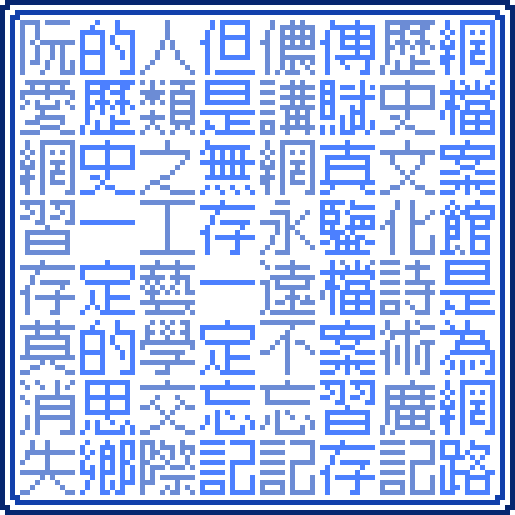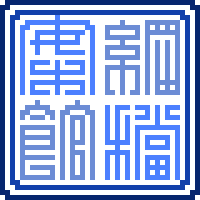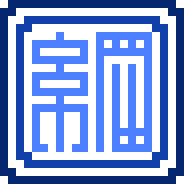Bibliotheca Anonoma/Logo: Difference between revisions
Antonizoon (talk | contribs) |
Antonizoon (talk | contribs) |
||
| (One intermediate revision by the same user not shown) | |||
| Line 16: | Line 16: | ||
== 2017: Declaration of Principles of the Bibliotheca Anonoma == | == 2017: Declaration of Principles of the Bibliotheca Anonoma == | ||
[[File:Bibliotheca_Anonoma_Declaration.png]] | |||
: ''The Bibliotheca Anonoma works to learn and save the data of Internet History, Poetry, Technology, Folklore, Tales [1-3].'' | : ''The Bibliotheca Anonoma works to learn and save the data of Internet History, Poetry, Technology, Folklore, Tales [1-3].'' | ||
| Line 32: | Line 34: | ||
#* The Bibliotheca Anonoma works (to learn [and] save) the Internet's, | #* The Bibliotheca Anonoma works (to learn [and] save) the Internet's, | ||
# 歷史, 文化, 詩/術/廣記 | # 歷史, 文化, 詩/術/廣記 | ||
#* [Hokkien] | #* [Hokkien] lek8-su2, bun3-ka7, si, sut4, kong5-ki1 | ||
#* History, Folklife, Poetry, Technology, | #* History, Folklife, Poetry, Technology, | ||
# 傳/賦/真鑒 檔案 習存. | # 傳/賦/真鑒 檔案 習存. | ||
Latest revision as of 19:50, 5 March 2017
These are the official names of the Bibliotheca Anonoma in various scripts:
- Latin Script - Bibliotheca Anonoma
- Definition - Archival Library, with some focus on anonymous/psuedo-anonymous internet communities.
- Etymology - Modeled after the name of the Bibliotheca Alexandrina, a modern national library of Egypt. "Anonoma" is a constructed word alluding to the organization's origins in the group Anonymous. It was likely concieved via false cognate to a variant spelling of the Spanish term for corporation, Sociedad Anónoma.
- Arabic Script - مكتبة الـأننما
- Etymology - Modeled after Egyptian Arabic name of the Bibliotheca Alexandrina. Anonoma is transliterated.
- Arabic - Maktabat al-Anonoma
- CJK Script - 網路檔案館
- Literal - Internet Archival Department/Museum
- Hokkien - bāng-lō tóng-àn kuan4
- Mandarin - Wǎng lù dǎng'àn guǎn
- Japanese - インターネット とうあんかん
- Cyrillic Script - Библиотека Анонома
- Etymology - Direct transliteration of Bibliotheca Anonoma to Cyrillic.
2017: Declaration of Principles of the Bibliotheca Anonoma[edit]
- The Bibliotheca Anonoma works to learn and save the data of Internet History, Poetry, Technology, Folklore, Tales [1-3].
- It is said that the internet never forgets, but unless archivists like us work to make that reality, it is inevitable that it will forget. [4-5].
- Humanity's early interaction with technology will definitely be looked back upon with nostalgia by the next digital civilization. [6-7]
- We have the duty to transfer that knowledge of analog past and present such that they shall not perish from a digital future. [8]
This extra large seal is a Hokkien poem detailing the purpose and direction of the Bibliotheca Anonoma. Composing it in actual Classical Chinese would have been a tremendous challenge, given that it has no accepted pronunciation. Hokkien is a language common to Taiwan, Singapore, Malaysia, and Fujian, and has very strong links to those dialects of the past. The Amoy Christian Bible and the Maryknoll Hokkien Dictionary are used as primary sources for vocabulary.
However, Hokkien does not actually have an established written standard, and about 20-25% of words do not have a recognized written analogue. Thus, Mandarin and Japanese characters are substituted in where needed.
needs 8 blocks 8x8 = 64
- 網檔案館, 是為網路,
- [Hokkien] bāng(-lō) tóng-àn kuan4 si5 wei4 sip4-cun,
- The Bibliotheca Anonoma works (to learn [and] save) the Internet's,
- 歷史, 文化, 詩/術/廣記
- [Hokkien] lek8-su2, bun3-ka7, si, sut4, kong5-ki1
- History, Folklife, Poetry, Technology,
- 傳/賦/真鑒 檔案 習存.
- [Hokkien] thoân, hu1, chin-gam3, tóng-àn sip4-cun7.
- Music, Folklore, Tales.
- 儂講網(路), 永遠不忘記
- [Hokkien] lang2 ko2ng bang2 (lou5) e2ng-oa2n be7 ki3-tit
- It is said that the internet never forgets,
- 但是無存, 一定忘記.
- [Hokkien] dam-shi bo-cun7, i-tim e ki3-tit.
- but if (data) is not archived, (the Internet) will inevitably forget.
- 人類之工藝學交際
- [Hokkien] ji5n-lu7i chi kang-ge7-ha8k kau-che3
- Humanity's early interaction with technology
- 的歷史一定的思鄉.
- [Hokkien] e le8k-su2 i-tim e su-hiong.
- will be looked back upon with nostalgia (by the next (digital) civilization).
- 阮愛網 習存, 莫消失.
- [Hokkien] goan2-ai4 bong2 sip4-cun7, mai4 siau-sit.
- We have the duty to study and archive that knowledge (of analog past and present) such that they shall not perish (from a digital future).
2016: Great Seal of the Bibliotheca Anonoma[edit]
http://i.imgur.com/i2FyvDg.png
In 2016, we drew up a new Bibliotheca Anonoma logo utilizing Classical Chinese seal script. It comes in three forms: 1x1, 2x2, and 4x4.
The 1x1 logo is a designator with the character 網, representing "network", specifically the Internet.
The 2x2 logo is a simple transliteration of the name into CJK script, 網檔案館.
The 4x4 provides us a canvas for larger declarations, which define our intents for the organization. We composed a short 16 character poem Classical Chinese to carve, which is no small feat for a millenia old language with no accepted pronunciation.
- 1x1
網(インターネット, wang [lu]) - Internet - Alt. Favicon Logo
- 3x1
檔案館(とうあんかん, dang an guan) - Archival Department/Museum - 2x2(インターネット とうあんかん, wang [lu] dang an guan)網檔案館 - Internet Archival Department/Museum
- Official CJK name.
- 4x4
習, 存, 網史, 詩, 術, 廣記, 傳,賦,真鑒, 史記檔案- Learning [and] Saving the data of Internet History, Poetry, Technology, Folklore, Tales. - 2x2
成, 史, 詩, 術- Achievements, History, Poetry/Stories, Technology - Alt. Logo
- 8x4
有收集, 不讓消失, 有長壽存(unfinished, expand to 16) - Such that the achievements, history, lessons, and technology of our effective ancestors shall not perish from this earth
2015: First Seal Script Logos[edit]
For the BASLQC and BA Compendium logos, we wanted to try something different, and somewhat more challenging. We wanted to use Classical Chinese seal script to draw our logo, but with a twist: we would draw them as pixel art.
The ancient Small Seal script, standardized by the Qin Dynasty around the first millenium, surprisingly lends itself well to pixelization. This is likely an effect of it's vestigial use on Chinese seal stamps, which are carved into stone and thus give preference to thin slices.
A Chinese artist known as Waliwala created a very intriguing specimen that inspired us.
The regular, winding, straight lines of the characters wrap around in mazes that can be approximated using a pixel grid. While circular components exist, they aren't too sharp and can remain coherent as pixellized ovals.
Characters[edit]
The first challenge was to actually choose the characters to use. As a Chinese speaker, this was not a great difficulty as it would be for most Westerners: where cultural appropriation of the Orient creates some ridiculous tattoos.
However, the name had to match the poetic, multifaceted construction of Classical Chinese (which is as close to modern Mandarin as Latin is to English).
That way, four characters can pack quite a lot of meaning, as shown from these book titles and their long, ridiculously unwieldy English translations:
- 藝文類聚 - "Collection of Literature Arranged by Categories"
- 四庫全書 - "Complete books of the four [imperial] repositories"
- 天工開物 - "The Exploitation of the Works of Nature"
- 太平御覽 - "Imperial Readings of the Taiping Era"
- 通典 - ""Comprehensive Institutions""
- 太平廣記 - "Extensive Records of the Taiping Era"
- This classical chinese title standard can be used for Histories and Timelines.
- 高帝紀 - "Annals of Emperor Gaozu"
- 古今人表 - "Table of prominent people from past to present"
BA Compendium Logo[edit]
http://i.imgur.com/yJsMc3V.png
- Designer - Amersel
- Application - BA Compendium
- CJK Script - 虛擬書架
- Meaning - Virtual Bookshelf
- Tools - GIMP was used to draw this logo, on a ThinkPad X220 Tablet.
The first logo of this type was written and designed by Amersel (a core member of the Bibliotheca Anonoma) while he was working on the BA Compendium.
The best description of the BA Compendium is a digital bookshelf for top stories from the Bibliotheca Anonoma. As Classical Chinese predates these two concepts, the characters were chosen from approximate modern Taiwanese Mandarin terminology.
- 虛擬 - _Mandarin: Virtual. (lit) [empty/false] + [draft/proposition]
- Etymology - Derived from Taiwanese term for emulated x86 computing platforms: 虛擬電腦 (Virtual Machine)
- 書架 - Mandarin: Bookshelf. (lit) [document] + [shelf]
The design of this logo was our first serious attempt at this style, after shelving the project months ago. We met various roadblocks that had to be overcome with ingenuity and methodology, which we developed as we went along.
The layout of the seal would be arranged in a standard 4x4 grid. Borders between characters would be delineated as a cross, two pixels thick, to reduce visual mashup of adjacent characters. However, allowances were made for components like the pointed tip of 書. Finally, a casing of two nested squares with dented corners was used to neatly fit the seal together.
The first major challenge was to force the complex characters into coherent pixellized forms.
A critical design motif of squared seal script is it's compact complexity, where each line is usually one unit away from one another, and the character takes up as much empty space as possible.
Initially, all characters were drawn at once on a predetermined grid size of 42x42, which posed a problem when the 書 character could not be drawn in an aesthetically acceptable manner, due to the small space given. Resizing the entire seal would require the complete redesign of the other three characters, that already worked well with the current size.
This problem was overcome by first designing each character separately, compressing them as small as possible, and identifying expandable sections. Serifs and spirals were added to ends where aesthetically possible to fill empty space in the square.
Then, the character that needed the largest pixel square was chosen as the template size for the 4x4 grid. 書 used up 10x10 pixels, and all other characters were expanded to fit that standard.
(give an example of expandable sections)
After finishing the seal and adding some stylistic changes (such as cutting corners, adding serifs), we colored it in the four standard Bibliotheca Anonoma blue colors found in our Traditional Square Kufic logo.
The two bright colors were applied in a checkerboard pattern on the four characters. The brightest color of the set was used to highlight two significant glyphs: 擬書 [draft] + [document].
As an added bonus, a compact logo was created by taking one character from the name representative of the entire product: 架 (shelf), and using it as a small seal emblem.
http://i.imgur.com/egctXW8.png
Finally, after the logo was drawn and colored, it had to be scaled up to a viewable size: we chose 400x400 to stay consistent, accomplished by disabling subpixel handling on GIMP's Scale tool. The logo was exported as uncompressed PNG, as JPEG would introduce unsightly artifacts.
BASLQC Logo[edit]
http://i.imgur.com/1RFJhJ8.png
- Designer - Antonizoon
- Tools Piskel was used to draw this logo, on a Thinkpad X230 tablet.
A compact logo was also created for the BASLQC.
2012 - 2016: Traditional Square Kufic Logo[edit]
The logo of the Bibliotheca Anonoma from 2012-2016 utilizes a square Kufic logo, a style chosen for it's resemblance to abstract art and QR codes. It's a design style that is more than a thousand years old, yet somehow feels very modern. It is easy to draw, but difficult to master, and it encodes meaning within it's maze-like square pixels.
Square Kufic is a calligraphic artform designed to encode Arabic words in geometrically-patterned architecture. Square Kufic likely found influence from the Phags-pa Seals of the Mongols, which attempted to emulate Chinese Seal Script square forms. (In fact, it might be interesting to put together a pixel-art Chinese Seal Script logo as well.)
This logo was inspired by the Arabic programming language, "Alb", where the author depicted the beauty of it's code by making square kufic inscriptions of computer algorithms (a term derived from the work of mathematician Al-Khwarizmi).
This design guide is immensely helpful if you feel like making your own square kufic design.
All these logos were first designed on graph paper. Then, it was drawn using the the Kufi Murabba Tool by Bahraini designer Qassim Haider. It really helps to have a Wacom tablet, or just a cell phone touchscreen to draw in the lines.
Arabic Transliteration[edit]
Square Kufic utilizes Arabic script as a basis for it's calligraphy. Thus, the name of the Bibliotheca Anonoma was first transliterated into Arabic.
Since the Bibliotheca Alexandrina calls itself the "Maktabat Al-Alexandrina", The Bibliotheca Anonoma's name in Arabic is thus "Maktabat Al-Anonoma":
مكتبة الـأننما
- miim kaaf ta ba ta-marbutah ("Maktabat", Library)
- alef lam alef-hamza-above noon noon meem alef ("Al-Anonoma" - of Anonoma)
Bibliotheca Anonoma (First Square Kufic Logo)[edit]
http://i.imgur.com/KaOsgph.png
In the logo, "Al-Anonoma", in light blue, is centered and wrapped around by "Maktabat", in typical blue. Both are surrounded by a navy blue box.
The empty corner in the top-right could contain a standard square kufic inscription of the plain Arabic name.
The logo takes a lot of liberties with square kufic design rules. In order to fill all empty space, it breaks with Square Kufic Design tradition, lacks symmetry, and contains an excessive amount of vertical lines.
It wasn't long before we created the second version below:
Bibliotheca Anonoma (Traditionalist Square Kufic Design)[edit]
http://i.imgur.com/UkgBKok.png
http://i.imgur.com/uLyW9e3.png
This is the more traditional Square Kufic logo that we used during the early years.
It is diagonally symmetrical; both the top and right sides, and the bottom and left sides spell out "Maktabat Al-Anonoma", and the long, vertically extended lines of "Al Anonoma" lock together with each other.
(append graph paper draft of logo)
Bibliotheca Anonoma (Small Square Kufic Logo)[edit]
An alternate logo design suitable for smaller icons can be used.
Logo Design[edit]
This design stacks "Maktabat" upside down on top of "Al-Anonoma".


